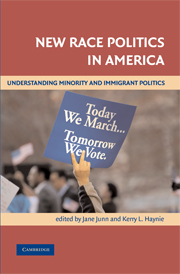Book contents
- Frontmatter
- Contents
- Contributors
- Acknowledgments
- 1 New Race Politics: The Changing Face of the American Electoral Landscape
- 2 In Whose Interest? Political Parties, Context, and the Incorporation of Immigrants
- 3 Beyond Black and White: The Experiences and Effects of Economic Status among Racial and Ethnic Minorities
- 4 Activity amid Diversity: Asian American Political Participation
- 5 Get Me to the Polls on Time: Coethnic Mobilization and Latino Turnout
- 6 Se Habla Espanol: Ethnic Campaign Strategies and Latino Voting Behavior
- 7 Structuring Group Activism: A Macro Model of Black Participation
- 8 Black Elites and Latino Immigrant Relations in a Southern City: Do Black Elites and the Black Masses Agree?
- 9 Understanding the New Race Politics: Conclusions and Challenges
- References
- Index
1 - New Race Politics: The Changing Face of the American Electoral Landscape
Published online by Cambridge University Press: 05 September 2012
- Frontmatter
- Contents
- Contributors
- Acknowledgments
- 1 New Race Politics: The Changing Face of the American Electoral Landscape
- 2 In Whose Interest? Political Parties, Context, and the Incorporation of Immigrants
- 3 Beyond Black and White: The Experiences and Effects of Economic Status among Racial and Ethnic Minorities
- 4 Activity amid Diversity: Asian American Political Participation
- 5 Get Me to the Polls on Time: Coethnic Mobilization and Latino Turnout
- 6 Se Habla Espanol: Ethnic Campaign Strategies and Latino Voting Behavior
- 7 Structuring Group Activism: A Macro Model of Black Participation
- 8 Black Elites and Latino Immigrant Relations in a Southern City: Do Black Elites and the Black Masses Agree?
- 9 Understanding the New Race Politics: Conclusions and Challenges
- References
- Index
Summary
Democracy in the United States always has been characterized by dynamism – states entered and attempted to leave the union, political parties were born and faded away, and the composition of the electorate underwent continuous alteration as women, minorities, and young people were included as eligible voting citizens. The United States is experiencing another set of changes that portend a potentially important reconfiguration of American democracy, and among the most significant is the introduction of a substantial number of immigrants to the polity. Overwhelmingly from Latin America and Asia, immigrants and their children currently make up more than 20 percent of the U.S. population. As a consequence, more than one-third of Americans consider themselves to be a race other than white. What difference will an estimated twenty-two million potential new voters – the combined total of the eleven million foreign-born Americans who became naturalized citizens since the 1990s and the eleven million who are eligible for naturalization now or within the next few years (Fix, Passel, and Sucher 2003) – make for campaigns, election outcomes, political identities, and democratic representation? To what extent will blacks, Latinos, and Asian Americans engage in a racial pluralism forged in identity politics? Should we expect racial groups to cohere politically? To what extent can racial identity be used to mobilize Latino and Asian American populations? Alternatively, will the majority population engage in a countermobilization response to increasing numbers of minority Americans?
- Type
- Chapter
- Information
- New Race Politics in AmericaUnderstanding Minority and Immigrant Politics, pp. 1 - 16Publisher: Cambridge University PressPrint publication year: 2008
- 1
- Cited by



